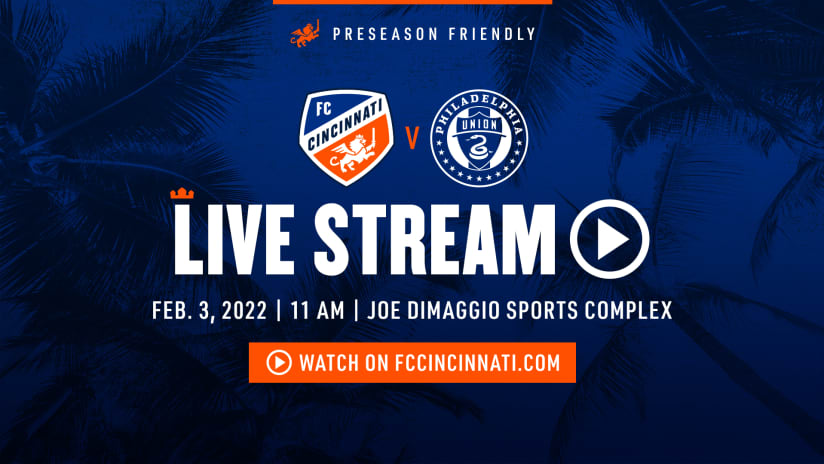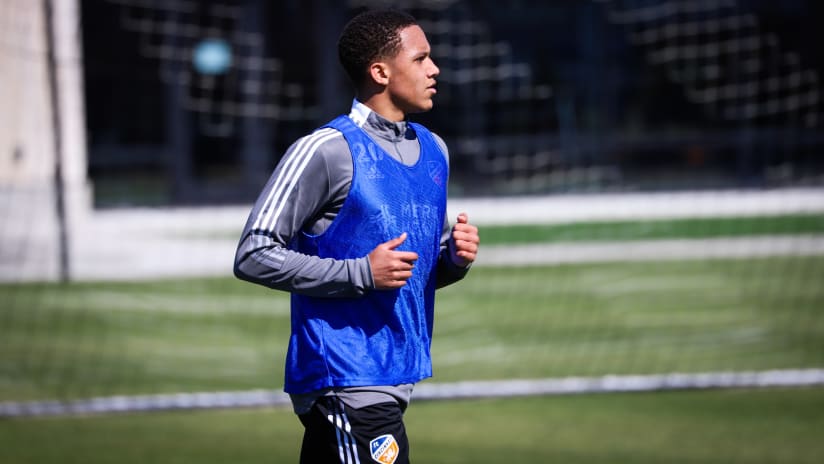Head Coach Alan Koch knows FC Cincinnati’s base system of play, but he’s keeping it close to the vest. Through five preseason matches, the club has regularly varied its starting formations. In last Saturday’s 2-1 win against the Charleston Battery, FCC used a 3-4-3. They’ll use it against the Chicago Fire on Wednesday night too, Koch said.
“Every formation obviously has strengths and weaknesses,” Koch said. “I think the system we played Saturday with the players we put together in that game was something that was going to make us dangerous. You can see we went out and created a lot of opportunities.”
Simplistically, the 3-4-3 is three defenders, four midfielders and three forwards. From there, roles and positioning on the pitch can rotate, flip or overlap.
In the case of Saturday’s win, Fanendo Adi was the main center forward, while Darren Mattocks and Roland Lamah played behind him. With help from the midfield, the three routinely generated chances against Charleston’s backline. As Koch noted, FCC were dangerous.
However, he pointed out a key area that needed some more work in that system.
“Defensively, we weren’t that sound,” Koch said. “Whatever formation we’re going to play, we’re going to make sure we’re defensively sound.”
Recently, being sound means keeping the backline intact. While the formation has changed up front, in the midfield and even on the wings, one thing has remained constant the last four matches: the back three.
When Koch first unveiled a lineup with three center backs, the trio included Kendall Waston, Nick Hagglund and Mathieu Deplagne.
They lasted 21 minutes together.
Waston was red carded for a tackle against the Colorado Rapids in a scrimmage on Feb. 2 and was eventually replaced by Hassan Ndam. Since that game, Waston has nursed an injury and hasn’t played.
“We’ve had injuries during preseason, so we’ve had holes we’ve had to plug,” Koch said. “But it’s also been an opportunity for players to show us what they can do in those positions, too.”
A consistent partnership is starting to show. In the last two matches, Hagglund and Deplagne have played alongside Forrest Lasso.
“That’s somewhere where you need major chemistry and you need to have a great understanding of each players’ strengths and each players’ weaknesses at the same time,” Koch said of the center backs. “We’ve tried a few different players together. We’ll continue to try different players together. We don’t just want three players comfortable playing together because we’re not going to play with the same three all season long.”
In a 3-2 loss at Indy Eleven last Tuesday, Lasso played 90 minutes alongside Hagglund and Deplagne to start, then Ndam and Tommy McCabe the last hour. Against Charleston, Deplagne played 90 minutes — the final 16 minutes with Ndam and Caleb Stanko.
Deplagne joined FC Cincinnati as a right back from Troyes AC of France, but said playing centrally is still comfortable.
“If I can help the team at center back, for me it’s no problem,” he said. “I did play in this position before, so for me it’s natural.”
Hagglund played in a back three the last three seasons at Toronto FC and said it’s going well at FC Cincinnati.
“I think it’s been good,” he said. “The Indy game was the only one we gave up multiple goals. I think the communication is getting better every game and we’re getting to know each other more every time we step on the pitch. It’s going to be good. It allows us to be more aggressive and be more together.”
If a back three sounds familiar for FC Cincinnati, it is.
When Koch became head coach in 2017, initially he deployed lineups with four defenders. Sometimes that meant a 4-2-3-1 or 4-3-3. Later, he used occasionally used a 4-4-2. But if one lineup became the norm in the second half of that season — and during the historic Lamar Hunt U.S. Open Cup run to the semifinals — it was the 3-4-3.
The first time FC Cincinnati used it was June 14 in a 1-0 win against Columbus Crew SC in the first Hell is Real Derby.
For the remainder of the U.S. Open Cup run, and for most of the USL season, the team kept its 3-4-3 shape. Cincinnati beat MLS teams in that formation. Now, if the team reverts back to it during the 2019 regular season, Koch hopes that continues.
“We’re trying different things,” he said. “We’re a new club and a new team in this league, so we have to try different things. I think if we don’t, if we just (assumed) there’d be one formation and that’s how it is, I think we’d be kidding ourselves.
“We tried a few things in preseason, but we definitely have a plan in terms of what we want our base to be. But we’re also going to have to adjust. I’m very, very happy with how we’re progressing with the plan. But obviously with any type of plan, there has to be minor deviations to come back to the plan,” Koch said.




